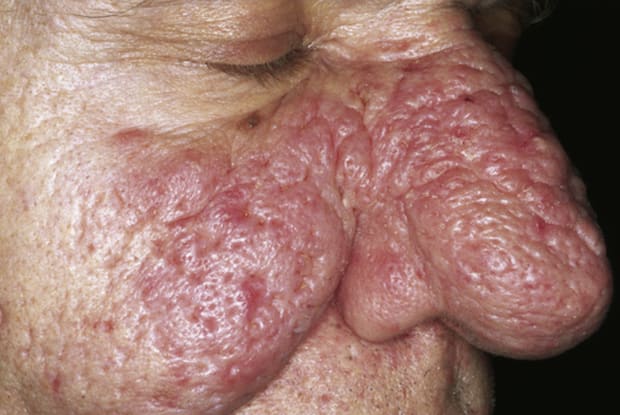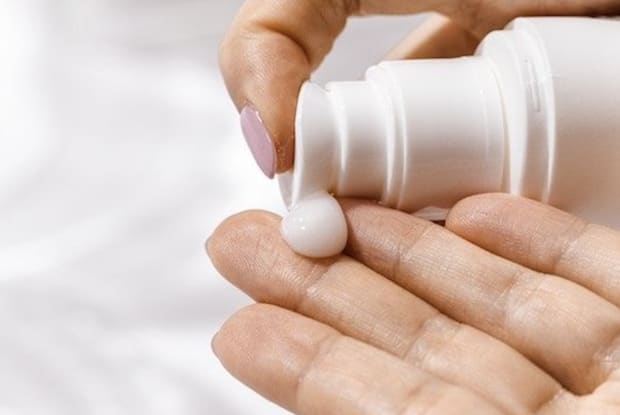Table of Contents
What is Rosacea?
Rosacea is one of the most common skin conditions in the United States. The condition affects around 16 million Americans at a time, with millions more in temporary remission. [1] Rosacea can affect anyone but is most commonly found in light-skinned, middle-aged women. [2]
Rosacea is recognizable by facial redness, especially in the cheeks and nose. A bulbous nose is also a common sign of rosacea. The symptoms of this condition can flare up in episodes that last weeks or months before patients go through a period without symptoms.
Keep reading to learn about the other symptoms of rosacea as well as the causes of this condition and how it can be treated with medications such as Mirvaso Gel (brimonidine), Azelex (azelaic acid), and Soolantra Cream (ivermectin).
Causes of Rosacea
The exact cause of rosacea is unknown. However, scientists believe that the condition is caused by a combination of environmental and hereditary factors. Rosacea is an episodic condition and there are several factors that may cause an outbreak. While different patients are likely to have different triggers, there are some common substances that may result in symptoms.
People that have rosacea should consider keeping a diary of when their symptoms occur, along with the weather, and the food and drink they consume. This can help patients narrow down their individual triggers.
Common rosacea triggers include: There are four different categories of rosacea and patients may have more than one type of condition. While the four subtypes are similar, each one has its own symptoms. [3] ETR (erythematotelangiectatic rosacea) causes redness in the face. This occurs when blood vessels underneath the skin grow and become visible through the skin. These symptoms occur in episodes but can become persistent or even permanent when not treated. [4] Acne rosacea (or papulopustular rosacea) is common in middle-aged women and causes breakouts similar to acne, hence the name. Pus-filled blemishes occur on the cheeks, forehead, and acne and this type of rosacea may also cause redness and flushing. As the name suggests, ocular rosacea causes symptoms that affect the eyes. Common symptoms of ocular rosacea include the eyes appearing bloodshot, watery, or feeling irritated. Additionally, ocular rosacea may cause cysts to form on the eyelids. [4] Rhinophyma (also known as phymatous rosacea) is a rarer form of rosacea that is more common in men. This condition results in the skin becoming swollen, discolored, thick, and scarred. The most obvious symptom of rhinophyma is a swollen and ‘bulbous’ nose. [4] This form of rosacea is typically accompanied by another subtype of the condition. There is no known cure for rosacea. However, treatments are available that can help manage symptoms. Your doctor will decide the best form of medication and treatment for you based on your symptoms and the severity of your condition. Many prescription medications used to treat rosacea are topical medications such as gels and creams. These medications are applied directly to the affected skin area in order to relieve your symptoms. A commonly used medication is Mirvaso Gel (brimonidine). This gel works to constrict blood vessels, which reduces redness. While this medication works quickly, the effects are only temporary and will need to be reapplied regularly. [5] Depending on your symptoms, your doctor may prescribe medications such as Azelex (azelaic acid) and Soolantra Cream (ivermectin). These topical medications are not as effective as reducing skin redness but can reduce the severity of pimples when necessary. For more severe rosacea, you may need to take an oral drug. Antibiotics such as Flagyl (metronidazole) can be used to kill bacteria that may be worsening your condition. In addition to using prescription medications, there are also other treatments that can improve the appearance of rosacea. Once again, these procedures are not permanent and may need to be repeated periodically. Common treatments include: Electrocautery uses an electric current to damage visible blood vessels. Laser Therapy uses very powerful lights that reduce the appearance and redness of larger blood vessels. Dermabrasion sands off your top layer of skin in order to lessen the visibility of rosacea. [5] Along with medications and medical procedures, there are some things you can do yourself to improve the appearance of rosacea. Keep a Diary: If possible, you should keep a diary of your symptoms in order to attempt to work out your individual triggers. These can then be avoided or limited where possible. Skincare: Skincare is very important for those with rosacea. Avoid using any creams or cleansers that contain harsh ingredients, including alcohol or are fragranced. Dry your skin with a soft cloth after washing the affected area to avoid irritation. Weather Care: High temperatures and other weather conditions can irritate the skin. Apply strong (SPF30+) sunscreen during hot weather and use moisturizer during cold weather or on windy days. [5] Massage: A gentle facial massage each day may help reduce swelling. Use your fingers and massage your face in a circular motion, starting in the middle and working outwards. [2] The content in this article is intended for informational purposes only. This website does not provide medical advice. In all circumstances, you should always seek the advice of your physician and/or other qualified health professionals(s) for drug, medical condition, or treatment advice. The content provided on this website is not a substitute for professional medical advice, diagnosis, or treatment.
Types of Rosacea
a. ETR
b. Acne Rosacea
c. Ocular Rosacea
d. Rhinophyma

How is Rosacea Treated?
a. Prescription Medications

b. Other Treatments
c. Lifestyle Tips
